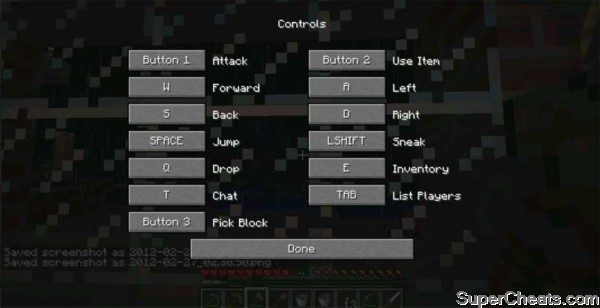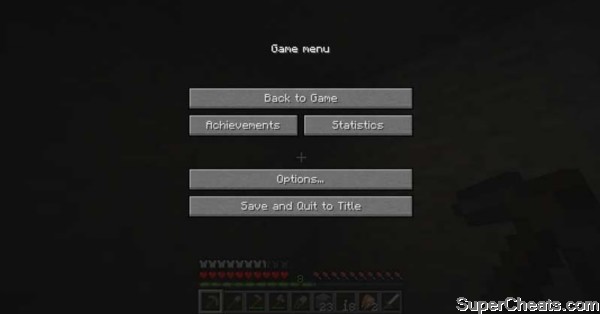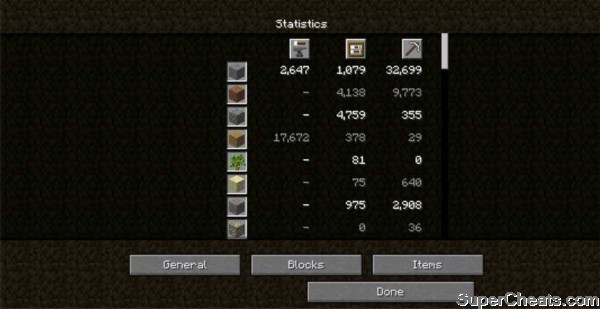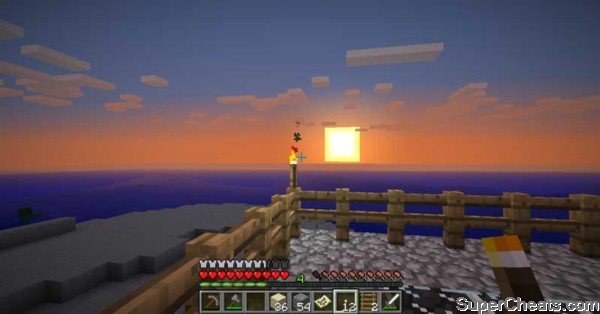
Controls and Settings
Minecraft Walkthrough and Guide
by CMBF ![]()
Controls and Settings
There are multiple versions of Minecraft that are based upon different platforms, so the controls will be slightly different between them. The most common versions of the game are the PC version and the Xbox 360 LIVE Arcade version, for which we cover the controls and settings here...
 Very Simple Controls for a Very Complicated Game |
Windows PC Controls
The primary controls in the game are split between the mouse and the keyboard, because movement used the keyboard while orientation and action largely uses the mouse.
Orientation (PoV): Mouse Movement
Left Mouse Button: Attack with Active Weapon / Use the selected Hot Bar Item.
Right Mouse Button: Place Selected Object / Open Door/Chest/Object
Movement Controls (Keyboard)
W - Move Forward
S - Move Backward
A - Move Left
D - Move Right
E: Open the Inventory Window
Number Keys 1 thru 9: Select Corresponding Hot Bar Box
Left Shift: Engage Sneak / Walk to Edge of Terrain without falling
ESC (Escape) Key: Access the Pause Menu
F3 - Display performance data and your current co-ordinates
Windows PC Pause Menu Screen
-- Back to Game: Return to the Game Window.
-- Achievements (Not for LIVE).
-- Statistics: General / Blocks / Items.
-- Options: Video Settings / Control Configuration / Language / Difficulty / Invert Mouse.
-- Save and Quite to Title: Save the game and quit to the Loading Screen.
Note: Of the above the Statistics and the Achievement screens are the ones you are most likely to return to often, and find interesting. Achievements in the game are actually structured as an unofficial and very loose Quest/Mission system in the game (which is by design according to Notch, and are intended to be strictly voluntary) which is why the nested trees are locked (the descriptions are hidden for Achievements that have prerequisites).
 The Pause Screen Menu for the PC Version of Minecraft |
The Statistics Screens offer you the opportunity to appreciate what you have been doing in a cumulative way -- revealing, among other interesting factoids, the following cumulative information (note that these are highlights, not a complete and comprehensive list of the Stat Items available):
--== Combat Stats ==--
-- Total Damage Dealt
-- Total Damage Taken
-- Total Mob Kills
-- Total Player Kills (in Multi-Player)
-- Total Number of Deaths (Yours)
--== Travel and Action Stats ==--
-- Fish Caught
-- Jumps
-- Total Distance Climbed
-- Total Distance Dove (Underwater)
-- Total Distance Fallen
-- Total Distance Flown
-- Total Distance Ridden (by Boat)
-- Total Distance Ridden (by Minecart)
-- Total Distance Ridden (on a Pig)
-- Total Distance Walked
In addition to the above information the game also keeps track of and charts for you the number of times you have Crafted, Used, and Mined the various resource objects, as well as the Use and Crafting of Tools and Items and the number of times you have fully depleted the durability (total use number) as well... Some of the stats can be shocking -- I knew that I liked to Fish (it relaxes me) but had no idea that I had caught THAT many Fish!
 The Numbers quickly Add Up in Minecraft |
Xbox 360 LIVE Arcade Controls
The primary controls for the game make very effective use of the Gamepad, and the generically similar controls found in the game should be familiar to any gamer who plays shooters...
Orientation (PoV): Left Joystick
movement: Right Joystick
Left Trigger: Attack with Active Weapon / Use the selected Hot Bar Item.
Right Trigger: Place Selected Object / Open Door/Chest/Object
(More Control Details Coming Soon)
Difficulty
The world in Minecraft comes in four basic difficulty levels: Peaceful, Easy, Normal, and Hard.
The primary difference between the four modes is that Peaceful Difficulty consists of a world that has no mobs -- and therefore very few dangers that are outside of the player's control -- while the other three difficulty modes do have mobs.
Most players will be playing the game on the default difficulty (Normal) -- though you may find that Peaceful Difficulty is useful when you just want to focus your attention upon building structures and devices without the hassle of being disturbed by mobs and the risks associated with nighttime play...
Of the remaining three three difficulty levels what differentiates them is mostly the mob spawn frequency and number, and the inherent stats that each mob type receives as their base stats -- meaning that the higher the difficulty the more HP each mob type has, and the higher damage they can deal.
Under most modes when you die (note that I did not say "If you die") the game respawns you at whatever the spawn-point is that you last set (in the case of a new game or a game in which you have not progressed to the point of crafting a Bed and thus have yet to set a new spawn-point, that point is wherever you originally entered the game on Map 0).
 Views like this make the difficulty worth it... |
When you respawn -- assuming for the moment that you set your spawn-point in your home -- you will appear nearby and can then simply run to your body to recover your items, which are now scattered on the ground near where you were killed. Note that if the mob is still in the area and was not killed in their attack on you, you may well still have to deal with them to get to your stuff. Also note that failing to reach your death point within a few minutes can result in some (or all if you really take too long) of your items disappearing from the game.
There is a hard 5-minute timer that guarantees that if you fail to get to your death point within 5 minutes you will lose all of the items you were carrying. Death by mob or mischance / accident does NOT effect items that are stored in chests in your Den -- so you should make it a practice to regularly transfer any really valuable loot and resources to your storage chests frequently, and try not to carry more resources on you than you actually need for the activity you are doing.
Player Character Experience and Levels
One of the misunderstood aspects of the game are the character levels, which are denoted in the game by the Green Bar that runs along the entire length of the status interface in the bottom center of the screen, consisting of 18 Green Dashes with the current Level in numerical form above it. When you fill all 18 dashes with XP, you advance to the next level.
XP Levels in Minecraft are very different than XP and Levels in most other games in that they are not so much a measure of your capabilities and prowess as they are a system for banking magical potential. If that confuses you think of it this way: The XP that you acquire from slaying mobs is really a measure of the "life force" that you drain away from them, in the form of glowing colored balls of energy that you must walk over to collect after the battle and after you have killed the mob.
In addition to the items that the mob drops -- which depending on the mob type can be very valuable -- the aforementioned colored balls are also "dropped" and, like loot, when you walk over or near them, your character collects them, adding their value to the progress meter and eventually leading to the acquisition of a new level.
Later when you have crafted a nice weapon -- like a Diamond Sword -- you may want to Enchant the weapon to give it extra power or a beneficial side-effect. To do this you use the Enchantment Table (the Enchanting Crafts Interface) in your Den. When you access the Enchantment Table you will find that there are three Enchantments listed. one of which you can apply at your choosing. Unfortunately these Enchantments are in a language you do not understand or read -- though it would be an idea to copy down the title for the one that you use so that you can start creating your own translation or at least learn the important words in Notchese, I am just saying.
In addition to being three different types of Enchantment each of the three has a different strength or level -- which is indicated by a number attached to its listing. THAT number directly corresponds to your Level -- that is to say that, for instance, let us say that you are Level 12 and the Enchantment that you have decided to use is the middle one, whose title you cannot read but that has a 4 listed as its Level/Strength. When you enchant your sword the Enchantment turns out to be Sharpness I -- which is a great Enchantment to add to your Sword! After you have added it, you will note that your Level is now Level 8, because that Enchantment "cost" you four levels to use.
Thus Levels in Minecraft are really a combination of banked Magical Energy or Life Force, and can be spent (exchanged really) on Enchanting -- and how cool is that?
More MineCraft on SuperCheats.com

No comments yet. Tell us what you think to be the first.